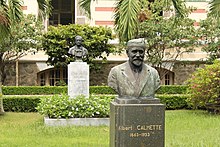Albert Calmette
Albert Calmette | |
|---|---|
antivenin | |
| Scientific career | |
| Fields | Bacteriology |
| Institutions | Pasteur Institute |
Léon Charles Albert Calmette
Early career
Calmette was born in
Association with Pasteur
Upon his return to France in 1890, Calmette met
.In 1894, he came back to France again and develop the first antivenoms for snake bites using immune sera from vaccinated horses (Calmette's serum). Work in this field was later taken up by Brazilian physician Vital Brazil, in São Paulo at the Instituto Butantan, who developed several other antivenoms against snakes, scorpions and spiders.[4]
He also took part in the development in the first immune serum against the
Institute leadership
In 1895, Roux entrusted him with the directorship of the Institute's branch at
In 1909, he helped to establish the Institute branch in Algiers (Algeria). In 1918, he accepted the post of assistant director of the Institute in Paris; the following year he was made a member of the Académie Nationale de Médecine.[4]
Research on tuberculosis

Calmette's main scientific work, which was to bring him worldwide fame and his name permanently attached to the history of
The vaccination program, however, suffered a serious setback when 72 vaccinated children developed tuberculosis in 1930, in Lübeck, Germany, due to a contamination of some batches in Germany. Mass vaccination of children was reinstated in many countries after 1932, when new and safer production techniques were implemented. Notwithstanding, Calmette was deeply shaken by the event, dying one year later, in Paris.[4]
Impact on industrial brewing
Calmette helped develop the amylolytic process which was used in industrial brewing.[6]
Personal life
He was the brother of Gaston Calmette (1858–1914), the editor of Le Figaro who was shot and killed in 1914 by Henriette Caillaux.[4] Mme Caillaux was acquitted of murder on the grounds that she had committed a crime of passion.
Legacy


Today, his name is one of the few remaining French names in the streets of Ho Chi Minh City (others being
References
- ISSN 1479-571X.
- PMID 22815009.
- PMID 10400286.
- ^ PMID 6359561.
- ISBN 978-84-17403-17-1.
- ISSN 0002-8762.
- ^ Luan, Kinh (22 January 2009). "Calmette Bridge completed". Saigon Times Daily. Archived from the original on 9 July 2021. Retrieved 5 September 2019.
- ^ "Calmette Hospital". Archived from the original on 5 September 2019. Retrieved 5 September 2019.
Bibliography
- OCLC 23392606.
- Calmette, A. (1896). "The Treatment of Animals Poisoned with Snake Venom by the Injection of Antivenomous Serum". BMJ. 2 (1859): 399–400. PMID 20756388.
- Hawgood, B.J. (August 2007). "Albert Calmette (1863–1933) and Camille Guérin (1872–1961): the C and G of BCG vaccine". Journal of Medical Biography. 15 (3): 139–46. S2CID 41880560.
- Daniel, T.M. (2005). "Leon Charles Albert Calmette and BCG vaccine". The International Journal of Tuberculosis and Lung Disease. 9 (9): 944–5. PMID 16158885.
- Milleliri, J.M. (2005). "Unpublished letter from Albert Calmette to Marcel Léger. A new mission for China?". Médecine Tropicale (in French). 65 (2): 135. PMID 16038352.
- Oehme, J. (August 1993). "Albert Calmette (1863–1933)". Kinderkrankenschwester (in German). 12 (8): 288. PMID 8398793.
- Bendiner, E. (October 1992). "Albert Calmette: a vaccine and its vindication". Hospital Practice. 27 (10A): 113–6, 119–22, 125 passim. PMID 1400676.
- Fillastre, C. (1986). "Homage to Albert Calmette". Developments in Biological Standardization (in French). 58 (Pt A): 3–7. PMID 3297869.
- Dodin, A. (1983). "Albert Calmette. President of the Société de Pathologie Exotique" [Albert Calmette. President of the Société de Pathologie Exotique]. Bulletin de la Société de pathologie exotique et de ses filiales (in French). 76 (3): 211–4. PMID 6354491.
- Birth, C.A. (March 1974). "Bacille Calmette-Guérin (BCG). Léon Charles Albert Calmette 1863–1933 Jean-Marie Camille Guérin 1872–1961". The Practitioner. 212 (1269): 391–2. PMID 4614251.
- Gelinas, J.A. (November 1973). "Albert Calmette. The Saigon years 1891–1893: A historical review". Military Medicine. 138 (11): 730–3. PMID 4201992.
- Cossairt, J. (1973). "Stamps in radiology (Leon Charles Albert Calmette)". Radiology. 107 (3): 536. PMID 4581661.
- Togunova, A.I. (1971). "Half a century since the development and practical application of live BCG vaccine (Albert Calmette), (Camille Guérin)" [Half a century since the development and practical application of live BCG vaccine (Albert Calmette), (Camille Guérin)]. Problemy Tuberkuleza (in Russian). 49 (4): 1–6. PMID 4944950.
- Deschiens, R. (1966). "Homage to Madame Albert Calmette". Bulletin de la Société de pathologie exotique et de ses filiales (in French). 59 (6): 933–6. PMID 4868558.
- Dujarric De La Riviere, R. (1964). "Eulogy for Charles - Albert Calmette (1863–1933)". Bulletin de l'Académie Nationale de Médecine (in French). 148: 648–55. PMID 14262487.
- ROCCHIETTA S (1964). "Albert Calmette (1863–1933)". Minerva Medica (in Italian). 55: 1432–4. PMID 14225467.
- ""No Truce for Tuberculosis". 4. The Birth of BCG. Albert Calmette and Camille Guérin". Indian Journal of Medical Sciences. 18: 418–9. 1964. PMID 14179613.
- Togunova, A.I. (1964). "The Life and Work of Albert Calmette". Vestnik Akademii Meditsinskikh Nauk SSSR (in Russian). 19: 69–74. PMID 14255874.
- "Celebration of the Centenary of the Birth of Albert Calmette (1863–1933)". Semaine des Hôpitaux. Informations (in French). 42: 5–7. 1963. PMID 14095595.
- Lugosi, L. (1963). "Albert Calmette and Camille Guérin". Gyermekgyógyászat (in Hungarian). 14: 321–2. PMID 14097501.
- Vandeneden, J. (1963). "Albert Calmette. An Exciting and Productive Career". Revue médicale de Liège (in French). 18: 669–74. PMID 14095568.
- De Assis, A. (1963). "Albert Calmette. (Apropos of the First Centenary of His Birth)". Hospital (in Portuguese). 64: 1–11. PMID 14048912.
External links
- Works by Albert Calmette at Biodiversity Heritage Library
- Léon Charles Albert Calmette. WhoNamedIt site.
- Albert Calmette (1863–1933). Repères Chronologiques. Institut Pasteur, Paris (In French).
- Newspaper clippings about Albert Calmette in the 20th Century Press Archives of the ZBW
